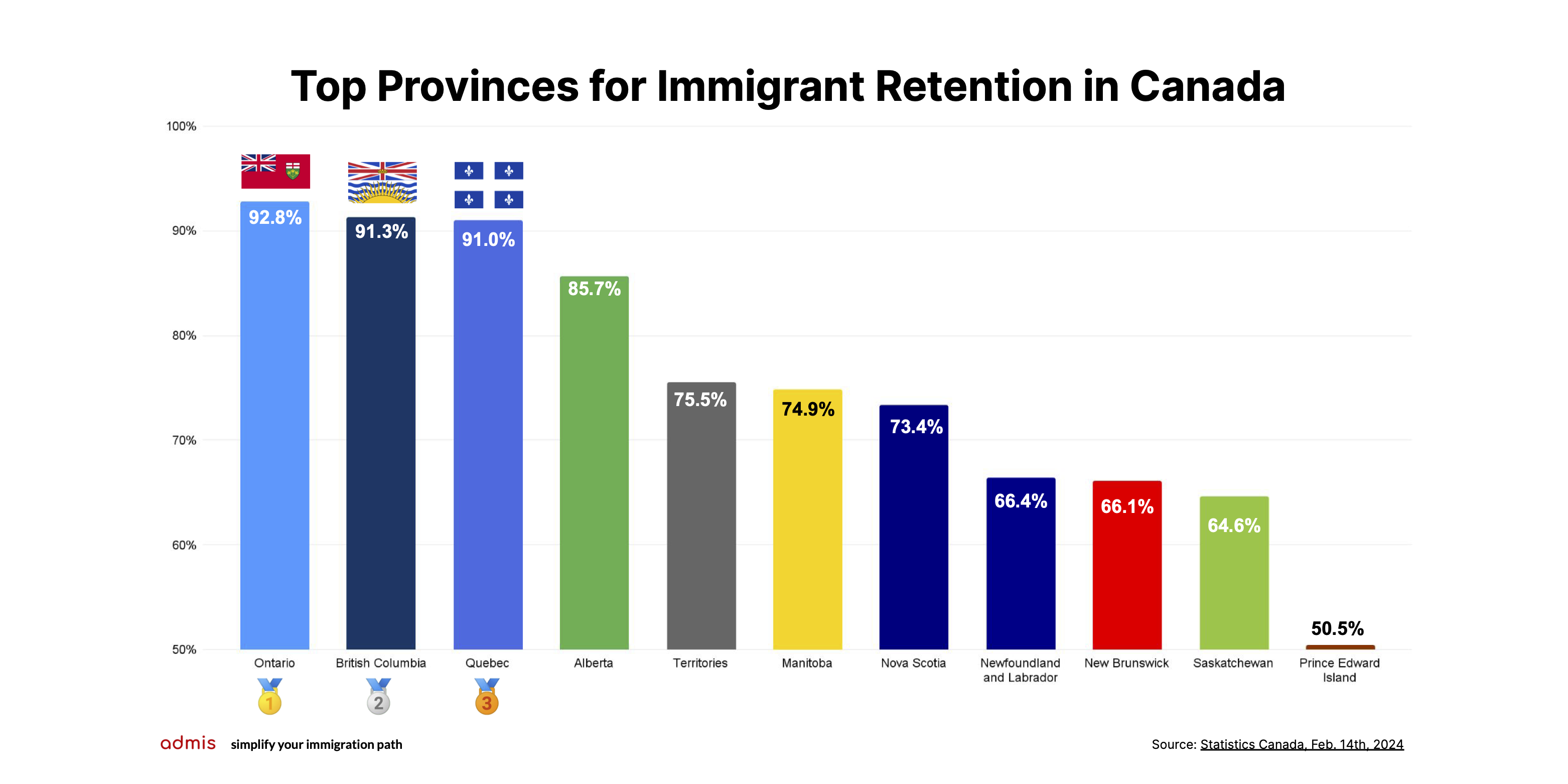Canada in 5: Top Provinces for Immigrant Retention Revealed

This week, we dive into Canada's immigration trends, from provincial retention challenges and the drive for Francophone immigrants to inspiring tales like Shazi Visram's entrepreneurial journey.
1. Top Story: Canada's Immigrant Retention Realities
A recent study published on February 14, 2024, by Statistique Canada uncovers a growing trend: more immigrants are choosing to leave Canada. This shift raises questions about retention and integration, spotlighting the need for effective strategies to keep newcomers rooted in Canada for its future prosperity.
Key Takeaways
- Top Immigrant-Retention Provinces: Ontario (92.8%), BC (91.3%), and Quebec (91%) lead with the best opportunities and communities.
- Looking Up in the Atlantic: Thanks to new programs, provinces like Nova Scotia are becoming more attractive to skilled immigrants.
- Challenges Out West: The Prairies and Territories need to up their game to keep immigrants.
Family vs. Work: Immigrants with family ties do well, but those moving for work face obstacles. - Choose Smart: Picking the right province is crucial for success in Canada.
Strong retention in major centers
In the bustling streets of Ontario, BC, and Alberta. These provinces boast the highest five-year retention rates, not just because of job opportunities but thanks to the dynamic, inclusive communities that make settling in a breeze. And while Quebec slightly trails behind, its rich cultural tapestry continues to draw newcomers seeking depth and diversity.
Challenges and opportunities in the Prairies and Territories
The Prairies and Territories present a rugged frontier for immigrants. Yet, it's here that resilience shines as local initiatives work tirelessly to bridge gaps. Despite facing hurdles like limited job sectors and developing support networks, these regions are ripe with potential for those willing to explore.
Progress in the Atlantic provinces
A beacon of hope arises in the Atlantic provinces, particularly with the successful Atlantic Immigration Pilot (AIP) program. Skilled immigrants find these provinces increasingly attractive, offering a blend of professional opportunities and community warmth.
The dual paths of family and work
Family-sponsored immigrants and refugees exhibit the highest retention rates (91.7% and 86.4% respectively for 2016 admissions), showcasing the vital role of community and family connections. Meanwhile, economic immigrants, particularly those under the Provincial Nominee Program, have seen a decrease, urging a closer look at these policies to ensure they align with market needs.
What this means for immigrants
The latest data on Canada's immigrant retention highlights a mix of promise and challenges. Adjusting policies to serve newcomers better is key to building a welcoming Canada where all can thrive. By fostering supportive communities and thoughtful initiatives, Canada positions itself as a home for diversity and opportunity.
2. Nova Scotia's Focus: Service Capacity Growth Challenges
Nova Scotia’s population surpassed 1 million in 2022, marking a milestone in its growth. However, the province faces challenges in providing adequate services for newcomers as demand increases.
- Nova Scotia’s population: Estimated at 1,047,232 in 2023.
- Goal: Reach a provincial population of 2 million by 2060 through an increase in international and interprovincial immigration.
- Immigration: In 2022, 795 Francophones settled in Nova Scotia, four times more than in 2021. The province aims to meet or exceed the federal government’s target for Francophone immigrants in Canada, which is 4.4% by the end of 2023.
- Bilingual advantage: Nova Scotia aims to attract more Francophone immigrants.
- Jobs: There were 7,531 jobs available in Nova Scotia in 2023. Additionally, there could be up to 52,100 job openings in Nova Scotia in the coming years.
3. Success Story: Shazi Visram's Path from Immigrant to Industry Pioneer
Migrating from Pakistan to Canada at just five years old, Shazi Visram embodies the essence of entrepreneurial success through her creation of Happy Family Brands. Known for its organic baby food, the company stands as a testament to innovation, sustainability, and social responsibility within the organic food sector. Visram's remarkable achievements have not gone unnoticed—earning her a spot as a Young Global Leader at the World Economic Forum and recognition on Forbes' 40 Under 40 list.


